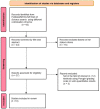Quantitative SPECT/CT Parameters in the Assessment of Transthyretin Cardiac Amyloidosis-A New Dimension of Molecular Imaging
- PMID: 37367407
- PMCID: PMC10299638
- DOI: 10.3390/jcdd10060242
Quantitative SPECT/CT Parameters in the Assessment of Transthyretin Cardiac Amyloidosis-A New Dimension of Molecular Imaging
Abstract
Aims: Cardiac transthyretin amyloidosis (ATTR) represents the accumulation of misfolded transthyretin in the heart interstitium. Planar scintigraphy with bone-seeking tracers has long been established as one of the three main steps in the non-invasive diagnosis of ATTR, but lately, single-photon emission computed tomography (SPECT) has gained wide recognition for its abilities to exclude false positive results and offer a possibility for amyloid burden quantitation. We performed a systematic review of the existing literature to provide an overview of the available SPECT-based parameters and their diagnostic performances in the assessment of cardiac ATTR. Methods and Methods: Among the 43 papers initially identified, 27 articles were screened for eligibility and 10 met the inclusion criteria. We summarised the available literature based on radiotracer, SPECT acquisition protocol, analysed parameters and their correlation to planar semi-quantitative indices.
Results: Ten articles provided accurate details about SPECT-derived parameters in cardiac ATTR and their diagnostic potential. Five studies performed phantom studies for accurate calibration of the gamma cameras. All papers described good correlation of quantitative parameters to the Perugini grading system.
Conclusions: Despite little published literature on quantitative SPECT in the assessment of cardiac ATTR, this method offers good prospects in the appraisal of cardiac amyloid burden and treatment monitoring.
Keywords: ATTR amyloidosis; SPECT/CT; amyloid burden; cardiac amyloidosis; molecular imaging; myocardium; restrictive cardiomyopathy.
Conflict of interest statement
The authors declare no conflict of interest.
Figures





Similar articles
-
Transthyretin Cardiac Amyloidosis Scintigraphy Using Planar D-SPECT on Dedicated Cardiac CZT Camera.J Nucl Cardiol. 2022 Aug;29(4):1995-2000. doi: 10.1007/s12350-021-02651-5. Epub 2021 May 11. J Nucl Cardiol. 2022. PMID: 33977371
-
Prognostic utility of the Perugini grading of 99mTc-DPD scintigraphy in transthyretin (ATTR) amyloidosis and its relationship with skeletal muscle and soft tissue amyloid.Eur Heart J Cardiovasc Imaging. 2017 Dec 1;18(12):1344-1350. doi: 10.1093/ehjci/jew325. Eur Heart J Cardiovasc Imaging. 2017. PMID: 28159995
-
Quantitative 99mTc-DPD-SPECT/CT assessment of cardiac amyloidosis.J Nucl Cardiol. 2023 Feb;30(1):101-111. doi: 10.1007/s12350-022-02960-3. Epub 2022 May 13. J Nucl Cardiol. 2023. PMID: 35562639 Free PMC article.
-
Radionuclide Imaging of Cardiac Amyloidosis.PET Clin. 2021 Apr;16(2):285-293. doi: 10.1016/j.cpet.2020.12.010. Epub 2021 Feb 12. PET Clin. 2021. PMID: 33589384 Review.
-
Diagnostic accuracy of bone scintigraphy in the assessment of cardiac transthyretin-related amyloidosis: a bivariate meta-analysis.Eur J Nucl Med Mol Imaging. 2018 Oct;45(11):1945-1955. doi: 10.1007/s00259-018-4013-4. Epub 2018 Apr 23. Eur J Nucl Med Mol Imaging. 2018. PMID: 29687207
Cited by
-
Novel Insights into Non-Invasive Diagnostic Techniques for Cardiac Amyloidosis: A Critical Review.Diagnostics (Basel). 2024 Oct 9;14(19):2249. doi: 10.3390/diagnostics14192249. Diagnostics (Basel). 2024. PMID: 39410653 Free PMC article. Review.
-
Prevalence of Incidental Findings Suspicious for Transthyretin Cardiac Amyloidosis among Patients Undergoing Bone Scintigraphy: A Systematic Review and a Meta-Analysis.J Clin Med. 2023 Sep 1;12(17):5698. doi: 10.3390/jcm12175698. J Clin Med. 2023. PMID: 37685765 Free PMC article. Review.
-
Future Directions in Quantitative SPECT-CT Evaluation of Cardiac Transthyretin Amyloidosis: Correlation with Clinical and Morphological Parameters.Diagnostics (Basel). 2025 Feb 17;15(4):482. doi: 10.3390/diagnostics15040482. Diagnostics (Basel). 2025. PMID: 40002633 Free PMC article.
-
Treatment response assessment in transthyretin-related cardiac amyloidosis: an emerging clinical indication of bone-seeking radiopharmaceuticals?Eur J Nucl Med Mol Imaging. 2024 Feb;51(3):691-694. doi: 10.1007/s00259-023-06576-8. Eur J Nucl Med Mol Imaging. 2024. PMID: 38110712 No abstract available.
-
3D Simulation-Driven Design of a Microfluidic Immunosensor for Real-Time Monitoring of Sweat Biomarkers.Micromachines (Basel). 2024 Jul 23;15(8):936. doi: 10.3390/mi15080936. Micromachines (Basel). 2024. PMID: 39203587 Free PMC article.
References
-
- Garcia-Pavia P., Rapezzi C., Adler Y., Arad M., Basso C., Brucato A., Burazor I., Caforio A.L.P., Damy T., Eriksson U., et al. Diagnosis and Treatment of Cardiac Amyloidosis: A Position Statement of the ESC Working Group on Myocardial and Pericardial Diseases. Eur. Heart J. 2021;42:1554–1568. doi: 10.1093/eurheartj/ehab072. - DOI - PMC - PubMed
Publication types
LinkOut - more resources
Full Text Sources
Research Materials
Miscellaneous

